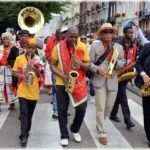“Paramaribo’s Presidential Palace: Colonial Elegance Meets Tropical Splendor in Suriname’s Historic Heart”
ROAMOPEDIA
Presidential Palace
Paramaribo’s Presidential Palace: Colonial Elegance Meets Tropical Splendor in Suriname’s Historic Heart
- Home
- /
- Country
- /
- Suriname
- /
- City
- /
- Paramaribo
- / Paramaribo’s Presidential Palace: Colonial Elegance Meets Tropical Splendor in Suriname’s Historic Heart
Related
All related contents.
Related Posts
Paramaribo’s Historic Inner City: UNESCO World Heritage Site – Unveiling Colonial Charm and Cultural Fusion

A Traveler’s Guide to Suriname: Unveiling the Secrets of South America’s Hidden Paradise
Discover the charm of Suriname’s growing gem – Lelydorp
Galibi Nature Reserve: Experience pristine beaches, witness nesting sea turtles, and discover vibrant birdlife.
Discover the natural wonders of Suriname at Brownsweg, your gateway to Brownsberg Nature Park and beyond.
Immerse in Authenticity: Discover Surinamese Culture & Hospitality Along the Upper Suriname River
Discover Suriname: Unveiling Paramaribo’s Wooden Marvel, the Saint Peter and Paul Cathedral
Jaw Jaw Village: Dive into Suriname’s Sipaliwini Heart – Where Culture, Crafts, and Cuisine Come Alive
Discover Suriname: Unearth the Secrets of Paramaribo, Journey to Jodensavanne, and Witness the Legacy of an Ancient Synagogue.
Discover Serenity at Brownsberg Nature Park: Hike, Explore, and Embrace the Wild!
Discover the rich heritage of Suriname’s mining town in the heart of the rainforest.
Ascend Voltzberg Dome, Witness Nature’s Majesty at Raleighvallen Reserve – Suriname’s Breathtaking Rainforest Hideaway.
Experience the fusion of history and culture in Paramaribo, Suriname’s lively capital city.
Discover the hidden gem of Suriname in Totness – where relaxation meets adventure.
Paramaribo Central Market: Discover Suriname’s Vibrant Heart of Culture, Craft, and Cuisine.
Paramaribo’s Palmentuin Park: Stroll into Serenity beneath Soaring Palms
Suriname’s Hidden Gem: Neveh Shalom Synagogue – A Journey Through Time, Culture, and Sand-Covered Floors
Discover Suriname’s hidden gem in Albina, where adventure meets nature on the Marowijne River.
Discover Paramaribo’s Vibrant Heart: Waterkant Street – Where Colorful History Meets Culinary Delights by the Suriname River
Discover the natural beauty of Suriname in Nieuw Nickerie.
Fort Zeelandia: Discover Paramaribo’s Living History at Suriname’s Cultural Treasure
Discover Suriname: Unveil the Secrets of Paramaribo, Wander Peperpot Nature Park, and Embrace the Rich History of a Reborn Plantation Paradise.
Related
Related contents and articles.
Related Posts
- Print
- Share
- +-Font Size